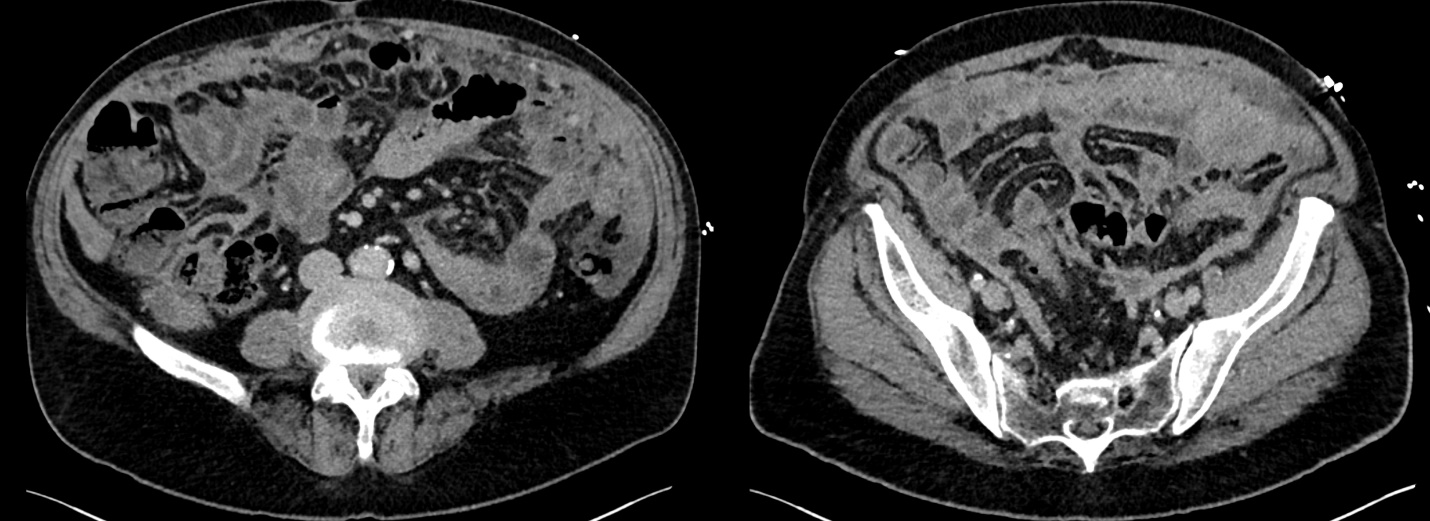Monday Poster Session
Category: Interventional Endoscopy
P3583 - Atypical Mesothelial Proliferation in a Patient With Occupational Asbestos Exposure and Clinical-Radiologic Presentation of Peritoneal Carcinomatosis
Monday, October 27, 2025
10:30 AM - 4:00 PM PDT
Location: Exhibit Hall

Nouman Shafique, MD (he/him/his)
AdventHealth Orlando
Orlando, FL
Presenting Author(s)
Nouman Shafique, MD1, Nihal I. Khan, MD1, Tareq Alsaleh, MD2, Jordan Lebron, MD3, Abdul Wasay, MD4, Tien-Anh Tran, MD3, Daniel Tambunan, MD5
1AdventHealth Orlando, Orlando, FL; 2Department of Internal Medicine, Adventhealth Orlando, Orlando, FL; 3AdventHealth, Orlando, FL; 4University of Tennessee, Knoxville, TN; 5Department of Internal Medicine, AdventHealth Orlando, Orlando, FL
Introduction: Peritoneal carcinomatosis is often linked to metastatic gastrointestinal or ovarian malignancies, while primary peritoneal mesothelioma remains a rare, aggressive entity. Diagnosing mesothelioma is challenging due to nonspecific symptoms and often inconclusive pathology. Occupational asbestos exposure remains the most significant risk factor. We present a case with clinical-radiologic impression of rapid-onset peritoneal carcinomatosis, ultimately diagnosed with atypical mesothelial proliferation concerning for mesothelioma.
Case Description/
Methods: A 65-year-old male presented with progressive abdominal distention, unintentional weight loss, and reduced appetite. He also reported a history of working in construction, raising suspicion for asbestos exposure. Physical exam revealed visible abdominal distention and mild tenderness. CT abdomen/pelvis revealed diffuse peritoneal carcinomatosis. Tumor markers revealed an elevated CA-125 (387). EGD and colonoscopy were unrevealing. EUS was notable for omental thickening and enlarged celiac axis lymph nodes; fine needle aspiration (FNA) of a gastrohepatic lymph node demonstrated atypical mesothelial proliferation. Immunohistochemical staining was positive for mesothelial markers (WT-1, calretinin, CK5/6, CK7). BAP1 and MTAP staining were retained, making a definitive diagnosis of mesothelioma difficult. Despite extensive evaluation, final pathology remained consistent with atypical mesothelial proliferation highly suspicious for malignant mesothelioma. The patient rapidly declined and transitioned to hospice care. He passed away approximately one month after initial hospitalization.
Discussion: This case highlights the diagnostic complexity and rapid clinical deterioration associated with peritoneal mesothelioma. The presentation mimicked more common intra-abdominal malignancies, and imaging showed classic findings of peritoneal carcinomatosis. However, the absence of a clear primary tumor and the presence of atypical mesothelial cells on cytology prompted further investigation. Immunohistochemistry supported a mesothelial origin, but retained BAP1 and MTAP expression limited definitive classification as malignant mesothelioma. This underscores the limitations of cytologic and immunohistochemical tools in diagnosing mesothelioma, particularly in the absence of tissue biopsy. Occupational exposure to asbestos is a critical epidemiologic clue. Given the aggressive course, early recognition and multidisciplinary evaluation are essential.

Figure: Figure 1: CT scan showing widespread peritoneal carcinomatosis

Figure: Figure 2 showing histological slides showing atypical mesothelial cells and immunohistochemical staining positive for mesothelial markers
Disclosures:
Nouman Shafique indicated no relevant financial relationships.
Nihal Khan indicated no relevant financial relationships.
Tareq Alsaleh indicated no relevant financial relationships.
Jordan Lebron indicated no relevant financial relationships.
Abdul Wasay indicated no relevant financial relationships.
Tien-Anh Tran indicated no relevant financial relationships.
Daniel Tambunan indicated no relevant financial relationships.
Nouman Shafique, MD1, Nihal I. Khan, MD1, Tareq Alsaleh, MD2, Jordan Lebron, MD3, Abdul Wasay, MD4, Tien-Anh Tran, MD3, Daniel Tambunan, MD5. P3583 - Atypical Mesothelial Proliferation in a Patient With Occupational Asbestos Exposure and Clinical-Radiologic Presentation of Peritoneal Carcinomatosis, ACG 2025 Annual Scientific Meeting Abstracts. Phoenix, AZ: American College of Gastroenterology.
1AdventHealth Orlando, Orlando, FL; 2Department of Internal Medicine, Adventhealth Orlando, Orlando, FL; 3AdventHealth, Orlando, FL; 4University of Tennessee, Knoxville, TN; 5Department of Internal Medicine, AdventHealth Orlando, Orlando, FL
Introduction: Peritoneal carcinomatosis is often linked to metastatic gastrointestinal or ovarian malignancies, while primary peritoneal mesothelioma remains a rare, aggressive entity. Diagnosing mesothelioma is challenging due to nonspecific symptoms and often inconclusive pathology. Occupational asbestos exposure remains the most significant risk factor. We present a case with clinical-radiologic impression of rapid-onset peritoneal carcinomatosis, ultimately diagnosed with atypical mesothelial proliferation concerning for mesothelioma.
Case Description/
Methods: A 65-year-old male presented with progressive abdominal distention, unintentional weight loss, and reduced appetite. He also reported a history of working in construction, raising suspicion for asbestos exposure. Physical exam revealed visible abdominal distention and mild tenderness. CT abdomen/pelvis revealed diffuse peritoneal carcinomatosis. Tumor markers revealed an elevated CA-125 (387). EGD and colonoscopy were unrevealing. EUS was notable for omental thickening and enlarged celiac axis lymph nodes; fine needle aspiration (FNA) of a gastrohepatic lymph node demonstrated atypical mesothelial proliferation. Immunohistochemical staining was positive for mesothelial markers (WT-1, calretinin, CK5/6, CK7). BAP1 and MTAP staining were retained, making a definitive diagnosis of mesothelioma difficult. Despite extensive evaluation, final pathology remained consistent with atypical mesothelial proliferation highly suspicious for malignant mesothelioma. The patient rapidly declined and transitioned to hospice care. He passed away approximately one month after initial hospitalization.
Discussion: This case highlights the diagnostic complexity and rapid clinical deterioration associated with peritoneal mesothelioma. The presentation mimicked more common intra-abdominal malignancies, and imaging showed classic findings of peritoneal carcinomatosis. However, the absence of a clear primary tumor and the presence of atypical mesothelial cells on cytology prompted further investigation. Immunohistochemistry supported a mesothelial origin, but retained BAP1 and MTAP expression limited definitive classification as malignant mesothelioma. This underscores the limitations of cytologic and immunohistochemical tools in diagnosing mesothelioma, particularly in the absence of tissue biopsy. Occupational exposure to asbestos is a critical epidemiologic clue. Given the aggressive course, early recognition and multidisciplinary evaluation are essential.

Figure: Figure 1: CT scan showing widespread peritoneal carcinomatosis

Figure: Figure 2 showing histological slides showing atypical mesothelial cells and immunohistochemical staining positive for mesothelial markers
Disclosures:
Nouman Shafique indicated no relevant financial relationships.
Nihal Khan indicated no relevant financial relationships.
Tareq Alsaleh indicated no relevant financial relationships.
Jordan Lebron indicated no relevant financial relationships.
Abdul Wasay indicated no relevant financial relationships.
Tien-Anh Tran indicated no relevant financial relationships.
Daniel Tambunan indicated no relevant financial relationships.
Nouman Shafique, MD1, Nihal I. Khan, MD1, Tareq Alsaleh, MD2, Jordan Lebron, MD3, Abdul Wasay, MD4, Tien-Anh Tran, MD3, Daniel Tambunan, MD5. P3583 - Atypical Mesothelial Proliferation in a Patient With Occupational Asbestos Exposure and Clinical-Radiologic Presentation of Peritoneal Carcinomatosis, ACG 2025 Annual Scientific Meeting Abstracts. Phoenix, AZ: American College of Gastroenterology.
